I do not see burn in effects, maybe because I use the spread method.
Nice tool for spreading is the PCI bracket Always handy and it does not bent
Always handy and it does not bent
Nice tool for spreading is the PCI bracket
Of all the ideas in this thread, this seemed the most likely to end up with a broken logic board. So naturally I had to try it!I just want to chime in with how we fix it on the tech team that I'm on. Zip ties. These break all the time.
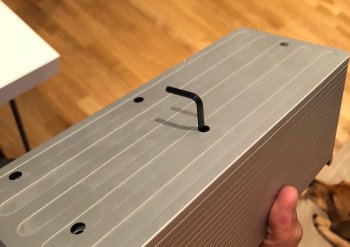
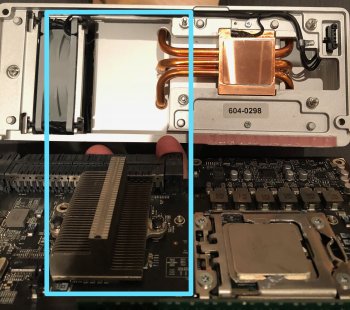
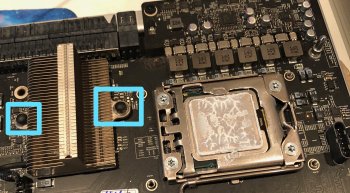
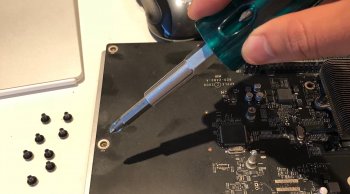
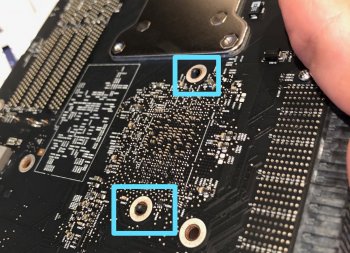
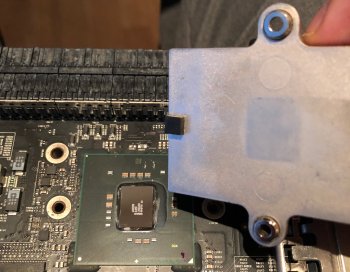
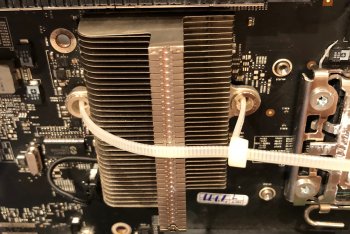
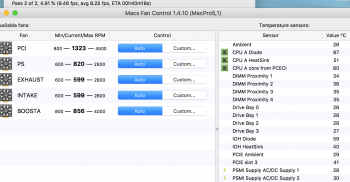

One day the springs just snapped with my office MP4,1. I've bought a pack of Chinese ones to replace and I've used a lot of on Mac minis 1,1/2,1 CPU heatsink, four used there. They just crumble.6.6 at 70°C over long time? = Bad idea!
Of all the ideas in this thread, this seemed the most likely to end up with a broken logic board. So naturally I had to try it!
First, for anyone new to mucking about with the Mac Pro heatsink, you need a long 2.5mm Allen key. Use it to loosen the five screws holding down the heatsink (you can't lose the screws, so just go until it stops spinning easily):
View attachment 773471
The IOH/chipset heatsink sits under the main heatsink, so you can see why the BOOSTA fan setting can greatly affect the chipset temperature:
View attachment 773476
The spring rivets in question are circled here:
View attachment 773472
First remove the standoff screws:
View attachment 773474
and you can see the backside of the logic board where the rivets stick out:
View attachment 773475
Now, I may have gotten some later-manufactured model or the original owner wasn't too hard on the Mac Pro, but my rivets were actually in great shape. I had to clip them with scissors for the purpose of this tutorial/my curiosity.
Wipe off the grease from the CPU and chipset heatsinks, and from the CPU and IOH chipset. I know some people use industrial degreasers and fancy arctic silver removal whatevers, but I've used a paper towel, Q-tips, and rubbing alcohol since I was mucking around with lidless AMD Athlons and Slot I Pentium IIs so it'll be fine here. Anyway, it should look kinda like this when you're done:
View attachment 773477
Then apply new heatsink grease to both the IOH chipset and the CPU. You do NOT need to apply it to the actual heatsinks.
Now stick one zip tie through one hole and another through the second hole, and lock them together. It'll look stupid and like it couldn't possibly work, but don't knock it till you try it...
View attachment 773478
(clip the excess zip tie like twerpin said)
Here's the funny thing - all this malarkey actually lowered my CPU/IOH temperatures. My CPU diode usually hovers around 70-80C under load (this is after already changing the CPU heatsink grease once), and the IOH diode anywhere from 70C-90C depending on how aggressively I set the BOOSTA fan.
Here's the temperatures under load (handbrake x265 encode), and all automatic fan control:
View attachment 773470
Setting the exhaust/intake/boostA profiles more aggressively (CPU diode, min/max 50C/90C) only lowers the temps a few more degrees:
View attachment 773469
So I'm guessing most of the benefit is cleaning out the 10-year-old heatsink grease that the Mac Pro originally shipped with. Anyway, wouldn't recommend doing this unless you absolutely have to. Even 70-80C is well within the tolerances for the chipset.
That said, I was able to turn down all of the fan settings in Mac Fan Control, so my Mac is even quieter than before!
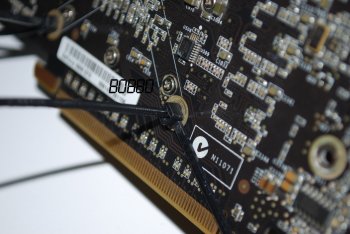
That’s probably the better way to do it, I just figured “F it” when I got to that pointIf I were to use zip ties to mount a heatsink, I would have used this method:
View attachment 773726
Use two zip ties for each mounting hole.
I have this same issue with my 2009 early MacPro and after reading this whole thread as well as any and all links I ordered everything I need to repair including a 2.5mm 9" long hex key only to find out that 2.5 is not the correct size and seems to be too small. Does anyone know what the actual size of the heads are on the bolts? Mine just spins inside the bolt head and not loosening anything.
I have this same issue with my 2009 early MacPro and after reading this whole thread as well as any and all links I ordered everything I need to repair including a 2.5mm 9" long hex key only to find out that 2.5 is not the correct size and seems to be too small. Does anyone know what the actual size of the heads are on the bolts? Mine just spins inside the bolt head and not loosening anything.
Thanks guys for the quick responses! I found a 3mm here that was long enough (barely) and got it opened up, replaced the one missing rivet, cleaned up the old thermal paste. Question now is - should I break off the old intact rivet and replace that one as well and how much thermal paste do I reapply??
Mine just broke by itself 2days ago cause my machine to freeze and i notice it from i-stat that my IOH T-diode temp was stay at 128'C.
I remove 2 of the pin form an only PC mono and replace the pin and hit another problem.
My Booster B fan was spinning at Max speed and i notice i-status shoe Booster B 0RPM i guess while i remove the heatsink it might had either damage the fan sensor or broken wire. damn.. ! i've hunt for a replacement CPU-B heatsink and notice the heatsink was at USD380 at Applecomponent.Any guru might be able to help here be nice.



If I were to use zip ties to mount a heatsink, I would have used this method:
View attachment 773726
Use two zip ties for each mounting hole.
Earlier this year I was able to temporarily resurrect a 2009 Mac Pro with snapped northbridge heatsink clip using zip ties in that cleaner arrangement. After replacing all the crusty dried thermal paste with some fresh Arctic MX-2 non-metallic thermal paste, the Mac Pro ran without issue for about 6 months. Then, recently, the same symptoms started happening again - shutting down just a few seconds after powering up.
This time I ordered the Chinese plastic spring rivets from ebay, they took about two weeks to arrive, I've just installed them and with some fresh thermal paste the system is running normally again. I used a diagonal cutter to snip off the top of the rivet that lives underneath the CPU heatsink, the plastic was fairly soft.
I notice that the plastic rivets hold the heatsink more tightly against the northbridge chip than the zip ties did. With the zip tie method I could wiggle the heatsink around slightly even when it was zipped as tightly as possible. The problem with zip ties is they are stepped, you can only zip them as tight as the nearest notch. By contrast, the spring rivets don't seem to allow the heatsink any wiggle room when installed, it sits tightly. I'm guessing the tiny bit of extra space allowed by the zip ties led to the thermal paste drying out and losing its effectiveness.
My advice would be to avoid zip ties, except as a temporary patch until you can get proper spring rivets as the designers intended.
Increased IOH Heatsink temperature with PCIe SATA boards
Hi,
I have two ATTO Tech SAS H608 cards installed in my Mac Pro with eight Samsung 1TB SSD, four of each in the two CD ROM bays, and each configured as RAID 0 software raid.
http://www.attotech.com/products/product.php?scat=27&prod=9&sku=ESAS-H608-000
I noticed that the IOH and IOH heatsink temperature increases significantly (from 60C to 85C) when I add ATTO Tech SATA cards for software RAID over four SSDs, especially when in heavy use, causing system freezes and instabilities. When I increase the fan speeds (exhaust fan) the system instabilities go away.
Has anyone noticed this? Does this makes even sense.
By the way, I have reseated my IOH Heatsink using simple Nylon screws and bolts on the bottom. Because they are nylon, they are sufficiently flexible to create a soft tension without too much pressure on the chip.
Thank You!
You could do, sure, but the chipset die is so small that it probably won't keep it fixated for long. My personal preference is to use rivets again, with adhesives and exposed dies you risk damage when you want to remove the heatsink to clean up. I already damage a PC motherboard because of this.Forgive my ignorance with the next question. I’ve never serviced the HS on my NorthBridge, so this is just a thought exercise.
Apparently it’s quite common for these fasteners to fail after sometime, and render the cMP useless until repaired.
Couldn’t you put an adhesive thermal compound on the chip during the repair, that would permanently affix the HS to the chip? In this way, if the fastener failed, I would think it would prevent a need to replace the rivet again.
I have no experience with these compounds, so maybe it’s not feasible at all. Just curious... It seems like (if that could work) it would be a better solution than zip ties.
I agree. In addition, adhesive thermal compound has worse thermal conductivity than regular paste. Either go with quality long life thermal paste or an IC carbon thermal pad coupled with plastic or metal push pins or rivets.You could do, sure, but the chipset die is so small that it probably won't keep it fixated for long. My personal preference is to use rivets again, with adhesives and exposed dies you risk damage when you want to remove the heatsink to clean up. I already damage a PC motherboard because of this.

